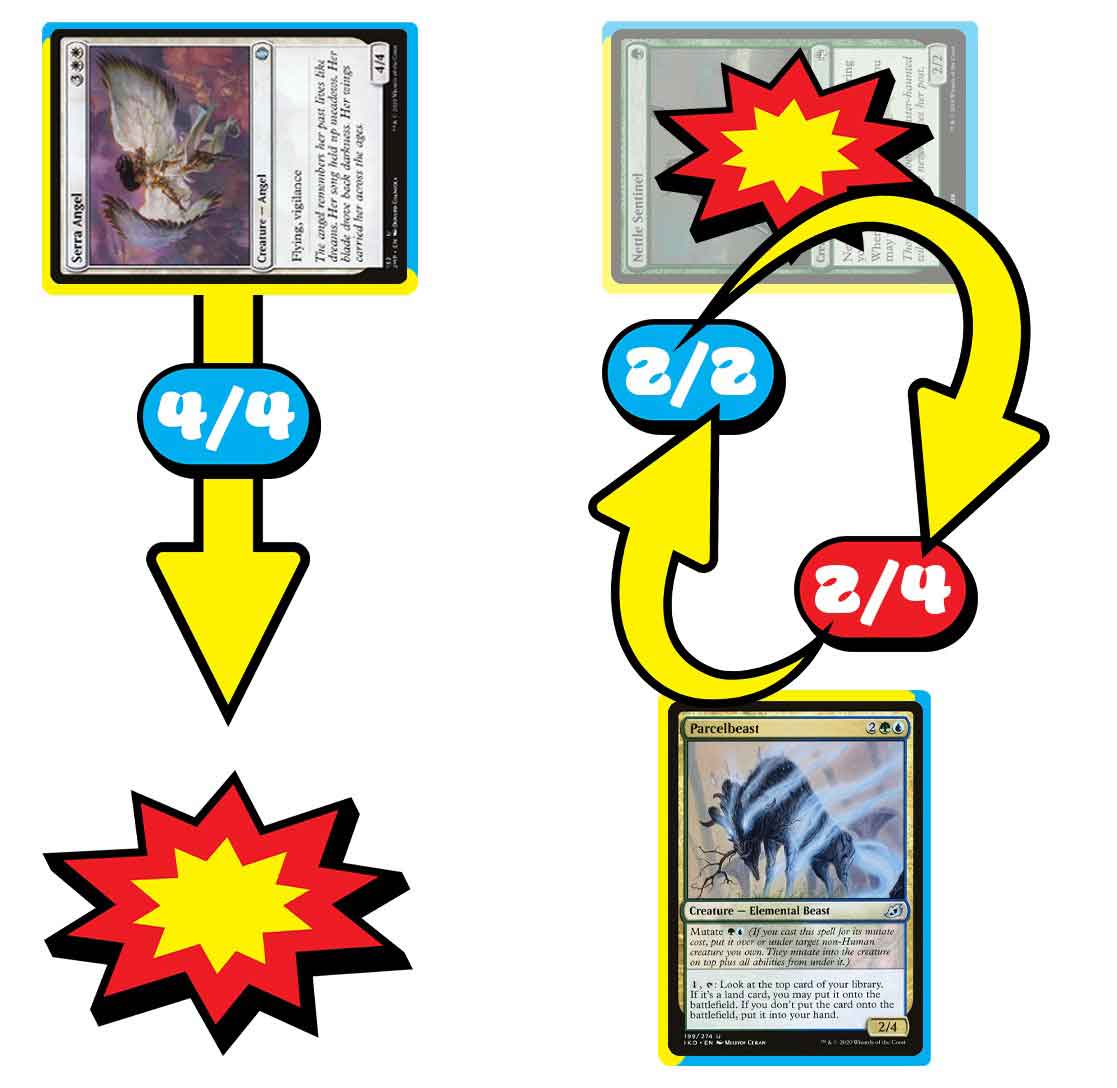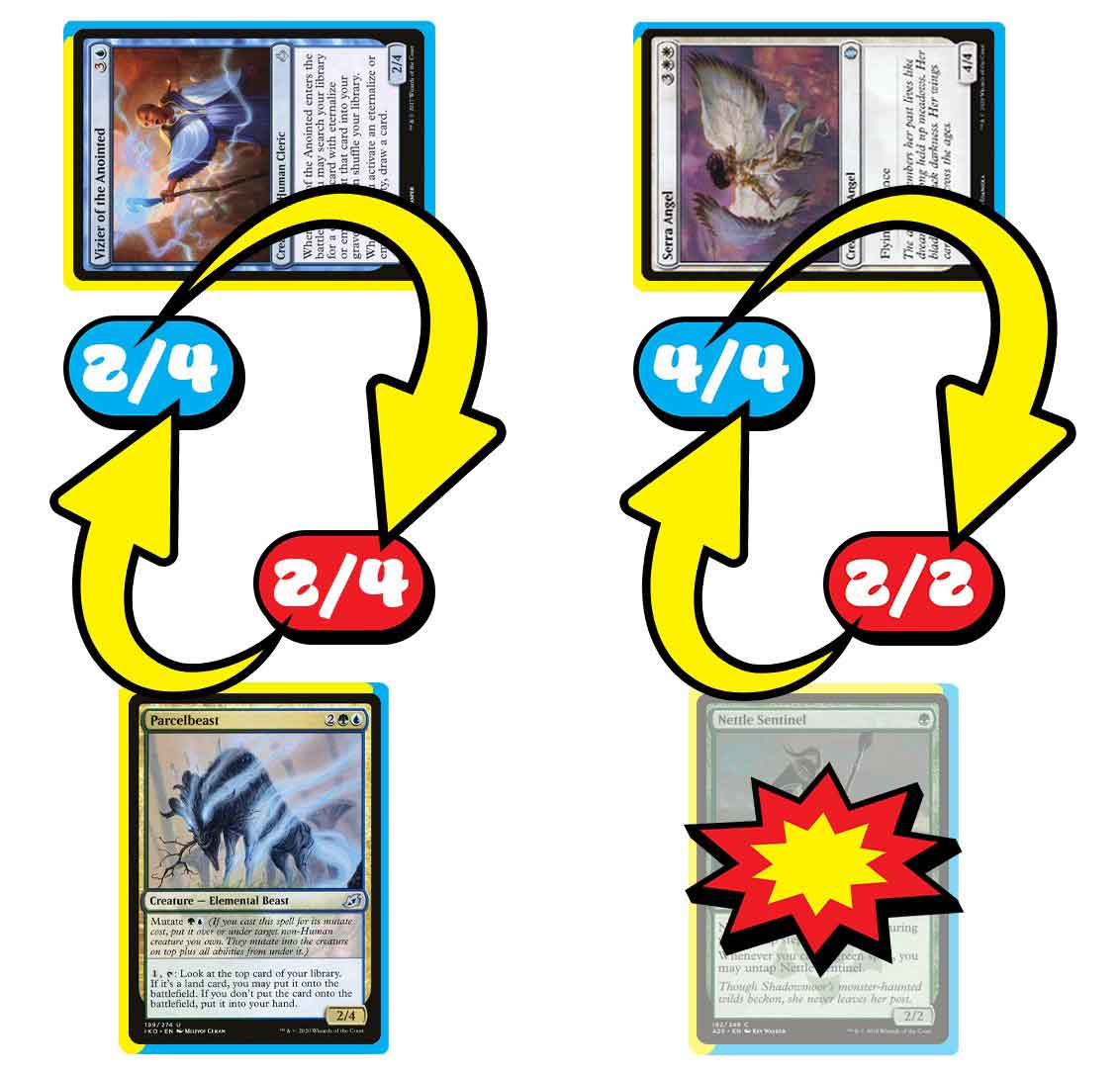
What is Magic the Gathering?
Magic The Gathering is a card game in which wizards cast spells, summon creatures, and exploit magic objects to defeat thier opponents. In the game , two or more players each assemble a deck of 60 cards with varying powers.

Basic Rules and Understanding for Beginners
This section describes the actions that you’ll take during a game, including tapping your cards, casting spells, attacking and blocking with creatures in combat.

Tapping and Untapping
To tap a card is to turn it sideways to show that it has been used for the turn. You do this when you use a land to make mana, when you attack with a creature, or when you activate an ability that has the symbol as part of its cost (means "tap this permanent"). When a permanent is tapped, you can’t tap it again until it’s been untapped (turned back upright). As your turn begins, untap your tapped cards so you can use them again.
Casting Spells
To cast a spell, you must pay its mana cost (located in the upper right corner of the card) by tapping lands (or other permanents) to make that amount of mana which that spell requires. For example, if you were casting Serra Angel, which costs , 2 white mana 3 colorless, you could tap three basic lands of any type to pay plus two Plains to pay .
Once a spell has been cast, one of two things happens. If the spell is an instant or a sorcery, you follow the instructions on the card, and then you put the card into your graveyard. If the spell is a creature, artifact, or enchantment, you put the card on the table in front of you. The card is now on the battlefield.
Cards on the battlefield are called permanents to differentiate them from instants and sorceries, which are never on the battlefield.

ATTACKING AND BLOCKING
The most common way to win the game is to attack with your creatures. If a creature that is attacking and isn’t blocked, it deals damage equal to its power to that opponent.
The middle phase of each turn is the combat phase. In your combat phase, you choose which of your creatures will attack, and you choose which opponents they will attack. Tap your creatures to show that they are attacking. Your opponents then choose which of their creatures will block, if any. Tapped creatures can’t be declared as blockers.
Once all blockers have been chosen, each creature—both attackers and blockers—simultaneously deals damage equal to its power (the number on the left side of the slash in the lower right corner of the card).

An attacking creature that isn’t blocked deals damage to the player it’s attacking. An attacking creature that is blocked deals damage to the creature or creatures that are blocking it, and vice versa.
If damage is dealt to your opponent, they lose that much life.
If one of your attacking creatures is blocked by multiple creatures, you decide how to divide its combat damage among them. You must assign at least enough damage to the first blocking creature to destroy it before you can assign damage to the second one, and so on.
If a creature is dealt damage equal to or greater than its toughness over the course of a single turn (whether it be combat damage, damage from spells or abilities, or a combination of both), that creature is destroyed, and it goes to its owner’s graveyard (or "dies"). If a creature takes damage that isn’t enough to destroy it in a single turn, that creature stays on the battlefield, and the damage wears off at the end of the turn.
Parts of the turn
Beginning phase
Untap step : You untap all your tapped permanents. On the first turn of the game, you don’t have any permanents, so you just skip this step. No one can cast spells or activate abilities during this step.
Upkeep step : Players can cast instants and activate abilities. This part of the turn is mentioned on a number of cards. If something is supposed to happen just once per turn, right at the beginning, an ability will trigger "at the beginning of your upkeep."
Draw step : You must draw a card from your library (even if you don’t want to). The player who goes first in a two-player game skips the draw step on their first turn to make up for the advantage of going first. Players can then cast instants and activate abilities.
First Main Phase
You can cast any number of sorceries, instants, creatures, artifacts, enchantments, and planeswalkers, and you can activate abilities. You can play a land during this phase, but remember that you can play only one land during your turn. Your opponent can cast instants and activate abilities.
Combat Phase
Beginning of combat step : Players can cast instants and activate abilities.
Declare attackers step : You decide which, if any, of your untapped creatures will attack, and which player or planeswalker they will attack. This taps the attacking creatures. Players can then cast instants and activate abilities.
Declare blockers step : Your opponent decides which, if any, of their untapped creatures will block your attacking creatures. If multiple creatures block a single attacker, you order the blockers to show which will be first to receive damage, which will be second, and so on. Players can then cast instants and activate abilities.
Combat damage step : Each attacking or blocking creature that’s still on the battlefield assigns its combat damage to the defending player (if it’s attacking that player and wasn’t blocked), to a planeswalker (if it’s attacking that planeswalker and wasn’t blocked), to the creature or creatures blocking it, or to the creature it’s blocking. If an attacking creature is blocked by multiple creatures, you divide its combat damage among them by assigning at least enough damage to the first blocking creature to destroy it, then by assigning damage to the second one, and so on. Once players decide how the creatures they control will deal their combat damage, the damage is all dealt at the same time. Players can then cast instants and activate abilities.
End of combat step : Players can cast instants and activate abilities.
Second Main Phase
Your second main phase is just like your first main phase. You can cast any type of spell and activate abilities, but your opponent can only cast instants and activate abilities. You can play a land during this phase if you didn’t play one during your first main phase.
Ending phase
End step : Abilities that trigger “at the beginning of your end step” go on the stack. Players can cast instants and activate abilities.
Cleanup step : If you have more than seven cards in your hand, choose and discard cards until you have only seven. Next, all damage on creatures is removed and all “until end of turn” effects end. No one can cast instants or activate abilities unless an ability triggers during this step.
Ready to Play, Look at our Store!
Share information about your brand with your customers. Describe a product, make announcements, or welcome customers to your store.
- Choosing a selection results in a full page refresh.
- Opens in a new window.
